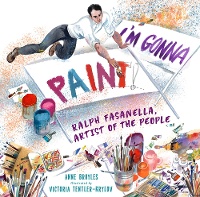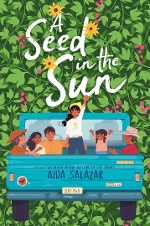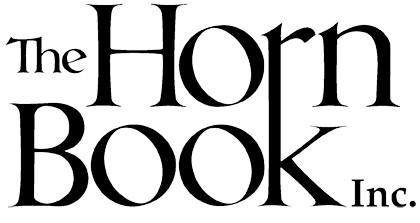
Find more great Horn Book content at these links:
Recommended books: reviews and themed booklists
App and e-book reviews
Movie reviews
Event news and recaps
Events calendar
May Day
In commemoration of International Workers' Day, or May Day, here are some book reviews and links to amplify the fight of workers and their efforts to secure better working conditions for all.
In commemoration of International Workers' Day, or May Day, here are book reviews to amplify the fight of workers and their efforts to secure better working conditions for all.
See also author Francisco Jimenez's 1999 Boston Globe–Horn Book Fiction Award speech for The Circuit plus recommended reading on "the circuit".
The following books were recommended by The Horn Book Magazine and The Horn Book Guide at the time of their publication; reviews are reprinted from the Guide/Reviews Database.
Primary
 Adler, David A. and Adler, Michael S. A Picture Book of César Chávez
Adler, David A. and Adler, Michael S. A Picture Book of César Chávez
32 pp. Holiday 2010
Trade ISBN 978-0-8234-2202-9
Illustrated by Marie Olofsdotter. Using quotes from their subject's autobiography, the Adlers tell an abbreviated life story of César Chávez, from migrant farm work in childhood through his life of activism to his death in 1993. Olofsdotter's warm-hued illustrations reflect the man's heritage and commitment to his cause. The book's source notes and other ancillary material are excellent. Timeline, websites. Bib.
 Brown, Monica Side by Side / Lado a lado: The Story of Dolores Huerta and César Chavéz / La historia de Dolores Huerta y César Chávez
Brown, Monica Side by Side / Lado a lado: The Story of Dolores Huerta and César Chavéz / La historia de Dolores Huerta y César Chávez
32 pp. HarperCollins/Rayo 2010
Trade ISBN 978-0-06-122781-3
Illustrated by Joe Cepeda. Translated by Carolina Valencia. Brown makes a significant contribution to the increasing number of books about César Chávez by focusing equally on his partner, Dolores Huerta. Their life stories are told in parallel until they meet and "side by side...began their journey." Huerta's accomplishments are admirable, and she gets her due in this heartfelt bilingual volume enhanced by Cepeda's emotion-filled mixed-media illustrations.
 Broyles, Anne I'm Gonna Paint: Ralph Fasanella, Artist of the People
Broyles, Anne I'm Gonna Paint: Ralph Fasanella, Artist of the People
48 pp. Holiday 2023
Trade ISBN 9780823450060
Ebook ISBN 9780823457380
Illustrated by Victoria Tentler-Krylov. In this engaging and child-friendly overview of Fasanella's (1914-1997) life and evolution as a self-taught, working-class artist, Broyles highlights the man's "rambunctious," resilient, and independent nature, even as a child. His hard-working Italian immigrant parents had limited resources and a large family to care for. As a boy, Fasanella accompanied his father as he delivered blocks of ice through the tenements of New York City. He listened to his factory-worker mother as she shared her strong beliefs about unionizing to improve working conditions. He was in and out of a Catholic reform school and worked odd jobs throughout the Great Depression before joining a union and learning to paint in his early thirties. He honed his craft and found his voice in his visual representations of family, baseball, and daily existence. He also documented momentous events (the March on Washington, the Kennedy assassination) and their impact on Americans, saying that "any good painting is a social statement" and that "art and politics can't be separated." Tentler-Krylov's dynamic watercolors bring her subject to life in small vignettes at various stages of the times and also place him in boldly colored, expansive scenes that pay homage to Fasanella's distinctive style. Well-researched back matter includes a timeline of events that are referenced in Fasanella's paintings, numerous reprints, and a listing of where to see more of the artist's work. A perfect companion to Levinson's The People's Painter (rev. 7/21), a picture-book biography of Ben Shahn.
 Harmony, Cynthia A Flicker of Hope
Harmony, Cynthia A Flicker of Hope
32 pp. Viking 2024
Trade ISBN 9780593525760
Spanish ISBN 9780593525791
Ebook ISBN 978059352578
Illustrated by Devon Holzwarth. As cold weather gives way to spring, the monarch butterfly migration begins, and Lucia's papa commences his own journey north. The forested region near the Mexican state of Michoacan is home to Lucia and her family (who are implied, from the back matter, to be Mazahua Indigenous people of the region) and to millions of monarchs, which hibernate there during winter months. Through lyrical text, Harmony describes the parallel journeys of the butterflies and migrant farm workers like Papa, who travel miles "across rivers and mountains" with a guiding sense of purpose; as he reassures his daughter: "When the weather turns cold and the monarcas return, our winged ancestors will guide me home." Lush greens of regional flora frame almost every page and ground the connection between nature and people. The illustrations — rendered in gouache, watercolor, pencil, crayon, and digital elements — capture the flitting motion of the monarchs, shifting viewpoints to allow readers to admire their patterned wings or marvel at the specks of orange flying en masse. An author's note detailing the monarch migration and the butterfly's cultural significance in the region; a Spanish glossary; and a "How Can We Help?" section are appended. Concurrently published in Spanish as Un aleteo de esperanza.
 Hopkinson, Deborah Thanks to Frances Perkins: Fighter for Workers' Rights
Hopkinson, Deborah Thanks to Frances Perkins: Fighter for Workers' Rights
40 pp. Peachtree 2020
Trade ISBN 978-1-68263-136-2
Illustrated by Kristy Caldwell. Not only was workers' rights advocate and public servant Frances Perkins (1880–1965) the first woman to serve in a presidential cabinet, she also improved the welfare of men, women, and children in the U.S. for generations. Over the course of her career, she fought tirelessly to increase workplace safety, reduce working hours, establish a minimum wage and unemployment insurance, and, most notably during her tenure as FDR's Secretary of Labor, institute our system of Social Security. Hopkinson uses Social Security as a framing device, beginning the text by posing two questions to modern readers ("How many years will it be until you turn sixty-two?" and "What year will that be?") and ending with a "Thanks, Frances!" In between, Hopkinson provides a broad overview of her subject's life, with the picture-book biography mostly highlighting a few seminal events that shaped Perkins's work ethic and determination. Caldwell's realistically drawn digital illustrations feature circular vignettes that occasionally depict additional accomplishments not covered in the text. The pastel color palette featuring teal and rose gold has an old-fashioned vibe, enhanced by period details. Back matter includes an author's note, a reading list, a bibliography, and source notes. Follow up with Kathleen Krull's more thorough account for slightly older readers, The Only Woman in the Photo (rev. 3/20), illustrated by Alexandra Bye.
 Krull, Kathleen Harvesting Hope: The Story of César Chávez
Krull, Kathleen Harvesting Hope: The Story of César Chávez
48 pp. Harcourt 2003
Trade ISBN 0-15-201437-3
Illustrated by Yuyi Morales. Showing how Chávez developed into an advocate and spokesman for migrant workers, Krull focuses on the march he led as part of a grape-pickers strike. The brief text creates a complex view of Chávez, and the mixed-media paintings are suffused with a variety of emotions. There are no sources, but this is an excellent choice for furthering understanding of racism, of nonviolent protest, and of the lives of workers before unions.
 Krull, Kathleen The Only Woman in the Photo: Frances Perkins & Her New Deal for America
Krull, Kathleen The Only Woman in the Photo: Frances Perkins & Her New Deal for America
48 pp. Atheneum 2020
Trade ISBN 978-1-4814-9151-8
Ebook ISBN 978-1-4814-9152-5
Illustrated by Alexandra Bye. President Roosevelt usually gets credit for the New Deal programs that helped pull America out of the Great Depression, but as Krull's latest picture-book biography (The Beatles Were Fab (and They Were Funny), rev. 5/13) makes clear, the real credit is due to "the first woman ever to join a presidential cabinet," FDR's Secretary of Labor Frances Perkins. A shy and quiet child, Perkins was always thinking about the injustices she saw growing up. Inspired by advice from her grandmother ("when someone opens a door to you go forward"), Perkins would spend her life speaking up for the most vulnerable as a pioneering social worker, suffragist, and author. She helped improve conditions in NYC's low-income neighborhoods and workplaces, and her activism led to a career in the "all-male world of politics." As Secretary of Labor, Perkins proposed "nothing less than a restructuring of American society" with the New Deal and the Social Security Act of 1935. This inspiring biography of a woman who paved the way for so many future leaders (as the cleverly designed endpapers make clear) is long overdue. Krull's straightforward yet passionate narrative is packed with information, succinctly pinpointing key biographical moments and explaining complex history. Direct quotes from Perkins in stylized hand-lettered script accompany Bye's child-friendly digital illustrations, which are as dynamic and colorful as their remarkable subject. An author's note and sources are appended.
 Lyon, George Ella Which Side Are You On?: The Story of a Song
Lyon, George Ella Which Side Are You On?: The Story of a Song
40 pp. Cinco Puntos 2011
Trade ISBN 978-1-933693-96-5
Illustrated by Christopher Cardinale. The narrator of this fictionalized tale lives in Kentucky “in a coal company house on coal company land…[Pa] says the company owns us sure as sunrise.” When company thugs harass the family, Ma, unfazed, scribbles words for the song that would become the union anthem. Lyon’s text captures the family’s sympathetic plight while Cardinale’s woodcuts display drama and energy. Author’s note. Bib.
 Markel, Michelle Brave Girl: Clara and the Shirtwaist Makers' Strike of 1909
Markel, Michelle Brave Girl: Clara and the Shirtwaist Makers' Strike of 1909
32 pp. HarperCollins/Balzer + Bray 2013
Trade ISBN 978-0-06-180442-7
Illustrated by Melissa Sweet. In her simple but powerful text, Markel shows how multiple arrests, physical attacks, and misogyny failed to deter Clara Lemlich as she set off on her lifelong path as a union activist in the early twentieth century. Clara's story is accentuated by Sweet's vivid illustrations, many of which are presented on fabric scraps or torn paper with borders of machine stitching. Bib.
 Winter, Jonah Mother Jones and Her Army of Mill Children
Winter, Jonah Mother Jones and Her Army of Mill Children
40 pp. Random/Schwartz & Wade 2020
Trade ISBN 978-0-449-81291-4
Library ISBN 978-0-449-81292-1
Ebook ISBN 978-0-449-81293-8
Illustrated by Nancy Carpenter. Creating a first-person narration (partly adapted from the labor activist's letters and speeches, as explained in an introductory note on the copyright page), Winter introduces readers to Mother Jones: "My name is Mother Jones, and I'm MAD. And you'd be MAD, too, if you'd seen what I've seen." Winter focuses mainly on the activist's work against child labor at the turn of the twentieth century, outlining the long hours, physical dangers, and low pay the children endured (while outside "the birds sang and the blue sky shone"). After visiting factories, notifying newspapers, and leading protests, Mother Jones decides to lead the child workers on a march from Philadelphia to Oyster Bay, New York (President Theodore Roosevelt's "fancy-schmancy Long Island summer home"). Throughout the text, frequent capital letters and bold fonts emphasize Mother Jones's strong message. Carpenter's watercolor and digital illustrations, created from a palette of blacks, grays, and tans, emphasize the dismal conditions and only begin to lighten as workers unite into unions. As the march progresses, she begins to include more color, culminating in a bright tableau when the children reach Coney Island and experience the pleasures there. That only three children make it all the way to Oyster Bay does not signal failure; the Children's Crusade paved the way for reforming child labor laws. The theme—that progress is worth fighting for and may not show immediate success—is there for the taking. Front and back endpapers showcase some of Mother Jones's precepts, such as "No matter what your fight, don't be ladylike"; the book concludes with an author's note providing more information on Jones, and a bibliography.
Intermediate
 Atkin, S. Beth Voices from the Fields: Children of Migrant Farmworkers Tell Their Stories
Atkin, S. Beth Voices from the Fields: Children of Migrant Farmworkers Tell Their Stories
96 pp. Little, Brown 2000
Trade ISBN 0-316-05633-2
The attractive presentation features children and teenagers of migrant workers, depicted in black-and-white photographs, speaking about family experiences, work, gangs, friends, and assorted fears, hopes, and dreams. Poetry by the young people, printed in both English and Spanish, is interspersed among the interviews. Bib.
 Carroll, Emma The Little Match Girl Strikes Back
Carroll, Emma The Little Match Girl Strikes Back
208 pp. Candlewick 2023
Trade ISBN 9781536233353
Illustrated by Lauren Child. In July 1888, women and girls working at a match factory in East London went on strike to protest dangerous working conditions and poor pay. Carroll takes the story of this significant event in labor history and uses it as the armature for her own version of Hans Christian Andersen's weeper "The Little Match Girl." Carroll's little match-seller has a name, Bridie, and a strong voice, luring customers with stories and outrageous patter. Her whole family is in the match trade, her mother in the factory, herself on the frigid streets selling, and her small brother at home fashioning match boxes. Like her nameless original, Bridie experiences visions, but unlike her predecessor she turns these visions into social action and survives to tell her tale. The mash-up of history and Andersen-tale works beautifully, especially on the metaphorical level with light, enlightenment, warmth, and energy battling it out against darkness, ignorance, chill, and despair. Child's illustrations, collages in black, gray, and red with a rich use of pattern, incorporate text at certain points to create an arresting, graphically dynamic page. Serve this up with Pinkney's lushly illustrated picture-book edition of the Andersen and with Maguire's Matchless for a feast of Victoriana and an invitation to discuss child poverty, capitalism, and the power of organized labor.
 Farrell, Mary Cronk Fannie Never Flinched: One Woman's Courage in the Struggle for American Labor Union Rights
Farrell, Mary Cronk Fannie Never Flinched: One Woman's Courage in the Struggle for American Labor Union Rights
48 pp. Abrams 2016
Trade ISBN 978-1-4197-1884-7
Garment-factory seamstress Fannie Sellins became a leader of the labor movement and "an angel of mercy" for striking workers' families. She was killed in 1919 when police turned clubs and rifles against protesters. Farrell relates the story of this extraordinary activist with deft pacing and relatable anecdotes; an engaging layout includes copious photos and primary source clippings. Reading list, timeline, websites. Bib., glos., ind.
 Jiménez, Francisco The Circuit: Stories from the Life of a Migrant Child
Jiménez, Francisco The Circuit: Stories from the Life of a Migrant Child
116 pp. Houghton 1999
Trade ISBN 0-395-97902-1
New ed (1997, Univ. of New Mexico). Originally published only in paperback, this is the first hardcover edition of the moving and transcendent book that won the 1998 Boston Globe-Horn Book Award for fiction; the appended author's note is from Jiménez's acceptance speech for that award. Look for sequels Reaching Out, Breaking Through, and Taking Hold.
 Otfinoski, Steven The Triangle Shirtwaist Factory Fire: Core Events of an Industrial Disaster
Otfinoski, Steven The Triangle Shirtwaist Factory Fire: Core Events of an Industrial Disaster
32 pp. Capstone 2014
Library ISBN 978-1-4765-4183-9
Paperback ISBN 978-1-4765-5132-6
Ebook ISBN 978-1-4765-5981-0
Fact Finders: What Went Wrong? series. This brief overview of the tragic Triangle Shirtwaist Factory fire contains a wealth of gripping details. The swift narrative begins with the blaze that ultimately killed 146 people, and ends with the development of new laws regulating working conditions. Eerie black-and-white photos of structural damage and victims illustrate the magnitude of the destruction, while sidebars expand on the information. Reading list. Glos., ind.
 Paterson, Katherine Bread and Roses, Too
Paterson, Katherine Bread and Roses, Too
275 pp. Clarion 2006
Trade ISBN 0-618-65479-8
This tale is about two children caught up in the 1912 Bread and Roses Strike in Lawrence, Massachusetts. Jake labors in the textile mills, and Rosa goes to school while her mother and sister toil. Both Jake and Rosa are unwilling coattail participants in the labor action. The themes (e.g., children forced by circumstance to an unnatural self-reliance) are familiar — but nobody does them better.
 Ryan, Pam Munoz Esperanza Rising
Ryan, Pam Munoz Esperanza Rising
262 pp. Scholastic 2000
Trade ISBN 0-439-12041-1
In this poignant look at the realities of immigration, thirteen-year-old Esperanza, daughter of an affluent Mexican rancher, is forced to trade fancy dolls and dresses for hard work and ill-fitting hand-me-downs after her beloved father dies. Laboring in the United States, picking grapes on someone else's land for pennies an hour, Esperanza is transformed into someone who can take care of herself and others.
 Salazar, Aida A Seed in the Sun
Salazar, Aida A Seed in the Sun
272 pp. Dial 2022
Trade ISBN 978-0-593-40660-1
Ebook ISBN 978-0-593-40661-8
In this lyrical verse novel set in 1965 California, Lula has lost her voice. She can only speak in "a whispery rasp" that doesn't help when she has to call out in the fields where she picks grapes with her family of migrant workers. It doesn't help when her father becomes angry and accuses her of not doing her part for the family's survival. And it doesn't help when there is danger and she needs to protect her siblings. With a stronger voice, she would make her case for attending school, but now that her mother has been stricken by a mysterious illness, that's not possible. When the exploited farmworkers start organizing and a woman named Dolores Huerta urges them to strike, things begin changing. Will her father be receptive to these ideas? Will her mother get medical assistance? Will Lula and her siblings return to school? Salazar seamlessly combines historical events of the farmworkers' rights movement and the 1965 Delano grape strike with a sensitive portrayal of a girl trying to make sense of the world. It's a powerful coming-of-age story filled with evocative language, memorable characters, and apt nature imagery. A lengthy author's note tells more about what Salazar calls "one of the greatest labor justice movements undertaken in United States history."
 Schrempp, Skyler Three Strike Summer
Schrempp, Skyler Three Strike Summer
320 pp. McElderry 2022
Trade ISBN 978-1-5344-9914-0
Ebook ISBN 978-1-5344-9916-4
Evicted from their Oklahoma farm in the midst of the Dust Bowl, the Willard family strikes out for California looking for work as migrant pickers. Scrappy Gloria Mae, the youngest child, tells the story, and Schrempp admirably never wavers from her perspective. Not fully understanding the scope of their circumstances, Gloria resents the move and the loss of all she knows, particularly her dream of playing baseball. She's good enough; even Pa admits, "You got the arm of a boy twice your size." When they arrive at a California peach orchard, they encounter despicable conditions: an unsafe working environment, low pay, squalid housing, and long hours. To quash dissent, managers intimidate the workers, forbidding group meetings, locking down the compound, and increasing police presence. For Gloria these are only background issues (she thinks that the forbidden "organizing" has something to do with arranging peaches); she has discovered the existnce of a baseball team at the orchard and vows to play. After a child is seriously injured in the orchard, Pa, who previously avoided all conflict, now believes that a strike is the only option for better working conditions. Gloria's struggles to join the team and her father's desire for change coalesce in Ma's words: "When you don't fight for what you deserve, the world just digs its heel into you a little bit more." An informative author's note adds historical context.
Older
 Baker, Julie The Bread and Roses Strike of 1912
Baker, Julie The Bread and Roses Strike of 1912
160 pp. Morgan 2007
Library ISBN 978-1-59935-044-8
American Workers series. This intelligent, well-documented account of the 1912 Lawrence, Massachusetts, strike pitting factory laborers against mill owner William Wood uses considerable primary material to tell how Industrial Workers of the World organizers advanced the workers' cause. Violence, deaths, Congressional investigations, and other disturbances ensued before the landmark strike succeeded. Well-captioned photos illustrate the text. Timeline, websites. Bib., ind.
 Brimner, Larry Dane Strike!: The Farm Workers' Fight for Their Rights
Brimner, Larry Dane Strike!: The Farm Workers' Fight for Their Rights
172 pp. Boyds/Calkins 2014
Trade ISBN 978-1-59078-997-1
Brimner's comprehensive history recounts the movement for better wages and working conditions among migrant farm workers in the Southwest, from California's burgeoning need for farm workers in the twentieth century to the story of César Chávez, the United Farm Workers of America, and the Delano grape workers' strike. The compelling narrative includes both textual and visual primary sources. Reading list, timeline, websites. Ind.
 Crowder, Melanie Audacity
Crowder, Melanie Audacity
389 pp. Philomel 2015
Trade ISBN 978-0-399-16899-4
This gripping historical verse novel is based on the life of Clara Lemlich, a Russian Jewish immigrant who worked tirelessly to help unionize and establish rights for fellow young women factory employees in the early twentieth century. Clara's driven and emotional voice radiates strength amid her doubts, fears, conflicts, and conviction to create a more equal world for women.
 Engle, Margarita Lion Island: Cuba's War of Words
Engle, Margarita Lion Island: Cuba's War of Words
163 pp. Atheneum 2016
Trade ISBN 978-1-4814-6112-2
Ebook ISBN 978-1-4814-6114-6
Engle (The Poet Slave of Cuba and companions) tells of nineteenth-century Cuba's Chinese indentured workers through Antonio Chuffat, a Chinese African Cuban boy who wants desperately to help the laborers seeking freedom from the indenture system; through his job as a messenger, he learns firsthand that words have power. Engle again weaves fiction and fact to create a lyrical tale. Reading list. Bib.
 Engle, Margarita Silver People: Voices from the Panama Canal
Engle, Margarita Silver People: Voices from the Panama Canal
260 pp. Houghton 2014
Trade ISBN 978-0-544-10941-4
In melodic verses, Engle offers the voices of the dark-skinned workers (known as the "silver people"), whose backbreaking labor helped build the Panama Canal, along with the perspective of a local girl. Interspersed are occasional echoes from flora and fauna as well as cameo appearances by historical figures. Together, they provide an illuminating picture of the project's ecological sacrifices and human costs. Bib.
 Jiménez, Francisco The Circuit: Graphic Novel
Jiménez, Francisco The Circuit: Graphic Novel
240 pp. HarperCollins/Clarion 2024
Trade ISBN 9780358348214
Paper ISBN 9780358348221
Ebook ISBN 9780358439349
Adapted by Andrew J. Rostan. Illustrated by Celia Jacobs. Jiménez's iconic, award-winning memoir — an episodic collection of short stories published in 1997 — receives a handsome graphic novel adaptation. Francisco's family leaves their small town on the outskirts of Guadalajara for the promise of a better life in California. Making their way to Mexicali, they dig under the wire fence to cross the border, finding employment in the southern part of the San Joaquin Valley as migrant farm workers. An early memory has a five-year-old Francisco watching his infant brother while his parents and older brother pick cotton. It's a hard life: constantly moving and uprooting themselves to find work; substandard housing, education, and medical care; and the entire family making sacrifices, both physical and emotional. Here, as in the original source material, Jiménez's plainspoken narration resonates with dignity, humility, and timelessness. The mixed-media illustrations convey both the time period and the mood of the piece with a limited color palette of olive green, lavender, and vermillion on a sepia background. (Francisco is drawn here with black hair and brown skin, rather than the fair skin and blond hair described in the original source and in the family picture that accompanies the author's note.) A glossary is also appended.
 Jiménez, Francisco Taking Hold: From Migrant Childhood to Columbia University
Jiménez, Francisco Taking Hold: From Migrant Childhood to Columbia University
200 pp. Houghton 2015
Trade ISBN 978-0-547-63230-8
This fourth volume of Jiménez's memoir series (The Circuit, etc.) covers graduate school at Columbia during the turbulent 1960s, his courtship and marriage to college sweetheart Laura, and their children's births. Throughout, Jiménez never forgets his beginnings as the child of migrant farm workers. The humble sincerity of Jiménez's prose makes us root for him to succeed. A selection of captioned photographs is appended.
 Ribay, Randy Everything We Never Had
Ribay, Randy Everything We Never Had
288 pp. Penguin/Kokila 2024
Trade ISBN 9780593461419
Ebook ISBN 9780593461433
Perspectives in this novel alternate among members of the Maghabol family from four different generations. In 1929, Francisco has recently emigrated from the Philippines to Watsonville, California, where he picks produce and eventually becomes a major labor organizer. In 1965, his son, Emil, has grown up without the presence of his constantly traveling father. Emil finds his way out of poverty by committing to academic and professional excellence. In 1983, Emil's son, Chris, struggles with pressures from his father, who expects him to assimilate and focus on school -- but a class project leads Chris to uncover deep and difficult histories of the Philippines, which is met with Emil's disapproval. And in 2020, Chris's son Enzo witnesses the effects of generational differences, rifts, and trauma when his grandfather moves in with the family as a precaution at the onset of the COVID-19 pandemic. In addition to exploring complex father-son relationships, Ribay takes the reader on a journey through Filipino American history, from the Manong Generation (young, single men who came to the U.S. in the early twentieth century) to the rise of anti-Asian hate crimes in 2020. A brief historical note and resources are appended.
 Tonatiuh, Duncan Undocumented: A Worker's Fight
Tonatiuh, Duncan Undocumented: A Worker's Fight
26 pp. Abrams/ComicArts 2018
Trade ISBN 978-1-4197-2854-9
Mexico-native Juan and his fellow undocumented workers in the U.S. are not being paid minimum wage or receiving benefits, although they work grueling hours, so they file a legal complaint for just compensation. This profound and timely human odyssey effectively uses an accordion-folded format inspired by Mixtec codices and employs many sequential and Mixtec art conventions. The direct and conversational text includes a smattering of Spanish words throughout.
 Walker, Sally M. Underground Fire: Hope, Sacrifice, and Courage in the Cherry Mine Disaster
Walker, Sally M. Underground Fire: Hope, Sacrifice, and Courage in the Cherry Mine Disaster
224 pp. Candlewick 2022
Trade ISBN 978-1-5362-1240-2
Ebook ISBN 978-1-5362-2470-2
Cherry, a town in north-central Illinois, had seemingly sprung up overnight once several veins of coal were discovered; most residents were recent immigrants. Walker opens her solid account by providing background about mining, immigration, and coal before getting to the events of November 13, 1909, when the Cherry Mine fire started after kerosene from a torch began dripping onto bales of hay. While many miners escaped, a good number remained trapped, waiting to be rescued. The narrative splits at this point, alternating between the miners' harrowing efforts to survive and the people waiting impatiently aboveground for news. Rescue efforts were complicated by the mine conditions: the temperature remained too hot, the air too poisonous, and embers smoldered, waiting to rekindle at any moment. Miraculously, a small group of men was rescued a week later, but the mine was then shut down for several months before the bodies of the dead could be recovered. While Walker draws attention to the corporate greed that led to unfair working conditions, including child labor, readers may also recognize some contemporary parallels to this story, including the rescue of thirty-three Chilean miners in 2010 (see Scott's Buried Alive!, rev. 7/12) and twelve Thai boys and their soccer coach in 2018 (see Soontornvat's All Thirteen, rev. 9/20). An assortment of maps, diagrams, and photographs accompanies the main text, while source notes, bibliography, and an index are appended.
 Watkins, Steve The Mine Wars: The Bloody Fight for Workers' Rights in the West Virginia Coalfields
Watkins, Steve The Mine Wars: The Bloody Fight for Workers' Rights in the West Virginia Coalfields
272 pp. Bloomsbury 2024
Trade ISBN 9781547612185
Ebook ISBN 9781547612192
West Virginia, the Mountain State, is also historically known for both coal mining and Appalachian poverty. Watkins explores the nexus between them in this overlooked chapter in the history of the labor movement. By the early twentieth century, West Virginia had emerged as a cheap source of coal, in large part because capitalism allowed wealthy mine owners to exploit workers. Coal mining was dangerous, the hours were long, the conditions deplorable, and the pay minimal — often paid in scrip, currency accepted only at the company store. The tension between mine owners and labor unions came to a head in 1920 during the Matewan Massacre and in 1921 during the Battle of Blair Mountain. Watkins introduces the major players and aptly delineates the causes and effects of these bloody and violent events. He reflects on how this history has been erased from books on West Virginia, a history that could have served as a source of pride in resistance. He concludes with a discussion of the current state of coal mining, still a mainstay of the area's economy despite mounting national pressure to move away from fossil fuels. Numerous black-and-white photographs ably support the text, while sources, notes, and an index are appended.
 Young, Jeff C. César Chávez
Young, Jeff C. César Chávez
160 pp. Morgan 2007
Library ISBN 978-1-59935-036-3
American Workers series. This thorough, well-documented biography recounts Chávez's progression from fieldworker in California to activist, union organizer, and civil rights advocate. Chávez's untiring efforts, extremely modest salary, refusal to back down, hunger strikes, and growing awareness of political process are emphasized, with the United Farm Workers Union as his crowning achievement. Considerable primary material is used, and captioned photographs illustrate the text. Timeline, websites. Bib., ind.
ALREADY A SUBSCRIBER? LOG IN
We are currently offering this content for free. Sign up now to activate your personal profile, where you can save articles for future viewing.







Add Comment :-
Be the first reader to comment.
Comment Policy:
Comment should not be empty !!!